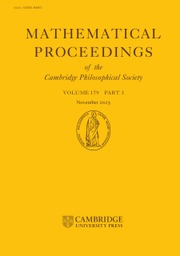Article contents
Fractional Brownian motion with deterministic drift: how critical is drift regularity in hitting probabilities
Published online by Cambridge University Press: 20 February 2025
Abstract
Let  $B^{H}$ be a d-dimensional fractional Brownian motion with Hurst index
$B^{H}$ be a d-dimensional fractional Brownian motion with Hurst index  $H\in(0,1)$,
$H\in(0,1)$,  $f\,:\,[0,1]\longrightarrow\mathbb{R}^{d}$ a Borel function, and
$f\,:\,[0,1]\longrightarrow\mathbb{R}^{d}$ a Borel function, and  $E\subset[0,1]$,
$E\subset[0,1]$,  $F\subset\mathbb{R}^{d}$ are given Borel sets. The focus of this paper is on hitting probabilities of the non-centered Gaussian process
$F\subset\mathbb{R}^{d}$ are given Borel sets. The focus of this paper is on hitting probabilities of the non-centered Gaussian process  $B^{H}+f$. It aims to highlight how each component f, E and F is involved in determining the upper and lower bounds of
$B^{H}+f$. It aims to highlight how each component f, E and F is involved in determining the upper and lower bounds of  $\mathbb{P}\{(B^H+f)(E)\cap F\neq \emptyset \}$. When F is a singleton and f is a general measurable drift, some new estimates are obtained for the last probability by means of suitable Hausdorff measure and capacity of the graph
$\mathbb{P}\{(B^H+f)(E)\cap F\neq \emptyset \}$. When F is a singleton and f is a general measurable drift, some new estimates are obtained for the last probability by means of suitable Hausdorff measure and capacity of the graph  $Gr_E(f)$. As application we deal with the issue of polarity of points for
$Gr_E(f)$. As application we deal with the issue of polarity of points for  $(B^H+f)\vert_E$ (the restriction of
$(B^H+f)\vert_E$ (the restriction of  $B^H+f$ to the subset
$B^H+f$ to the subset  $E\subset (0,\infty)$).
$E\subset (0,\infty)$).
MSC classification
Information
- Type
- Research Article
- Information
- Mathematical Proceedings of the Cambridge Philosophical Society , Volume 178 , Issue 1 , January 2025 , pp. 103 - 132
- Copyright
- © The Author(s), 2025. Published by Cambridge University Press on behalf of Cambridge Philosophical Society
References
REFERENCES
- 1
- Cited by

